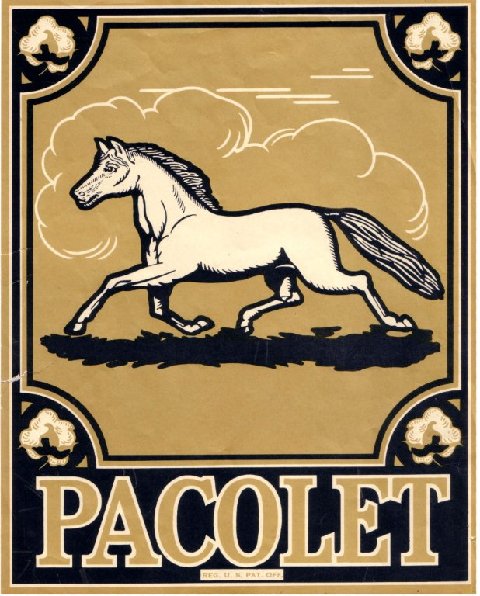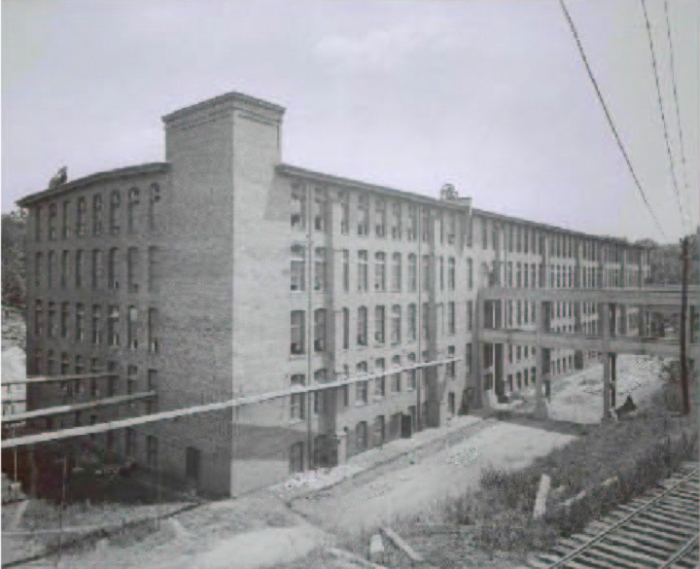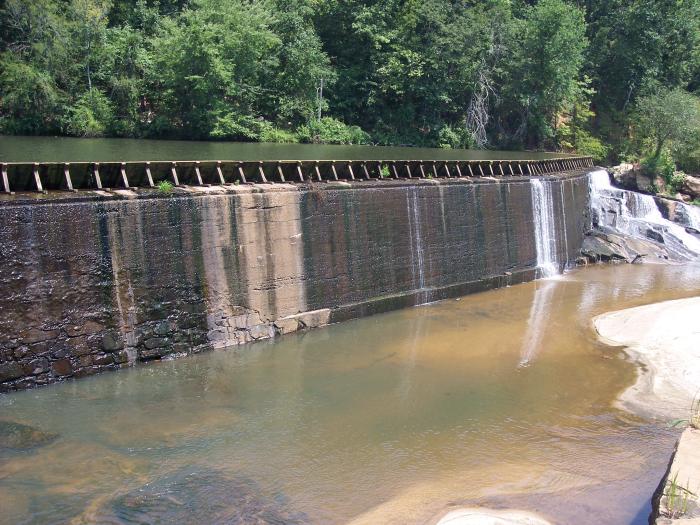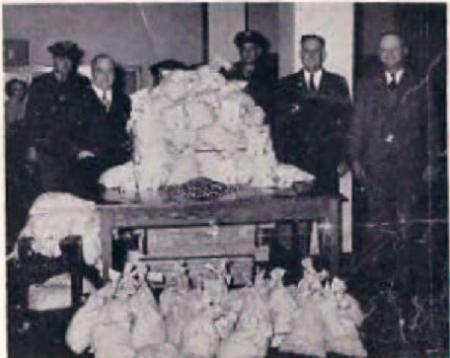The rushing water at Trough Shoals
was first used for the operation of a mill to grind corn
meal. This was built in the late 1700’s or early 1800’s
and was known as Hancock’s Mill. Part of the foundations
of this mill still exist below the dam. This mill shows up
on the Mills Atlas Map of 1825. Later on, water powered
mills to produce flour, saw lumber and to gin cotton were
also built on the Pacolet River at Trough Shoals.
The site was used for commercial purposes for well over a
half century before the textile industry came. A small
community existed at the present site of Pacolet Mills
before the coming of the textile industry.
The first Pacolet Manufacturing Company mill at Trough
Shoals was known as Pacolet Mill No. 1 or Pacolet No. 1.
It was completed in 1883 by John H. Montgomery, John B.
Cleveland, Joseph Walker, and Dr. Charles Edwards Fleming,
with the financial aid of Seth M. Milliken of New York.
The first dam over the river at this site was built just
before that date.
Mill No. 1 was three stories high and was right beside the
river at the south end of the dam. The mill flourished and
by 1884, it had 250 workers and about 500 people lived in
the village. The success of the mill led to the
construction of the four story Mill No. 2 as an addition
and enlargement of Mill No. 1. This construction
work was started in 1888 and this mill was also very
successful. Mills No. 1 and 2 stretched for 600 feet along
the river.
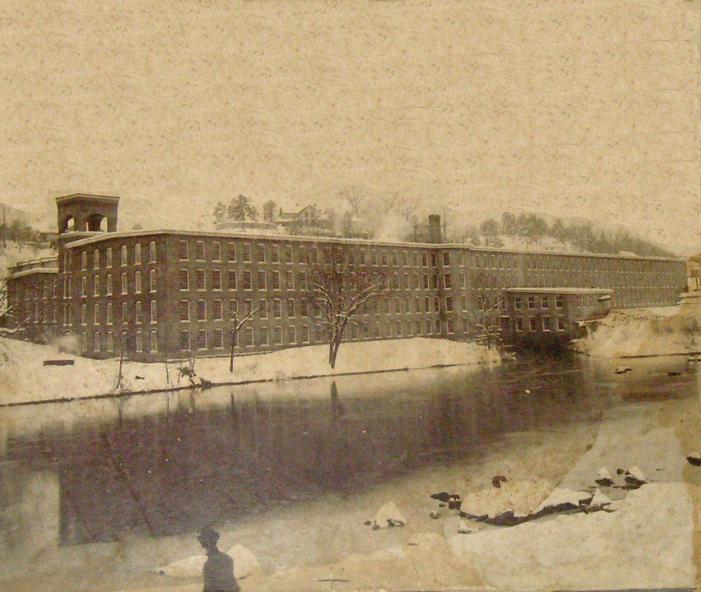 Old Photograph of Mills No. 1 and 2 taken before 1903
Old Photograph of Mills No. 1 and 2 taken before 1903
Based on the success of Mills No. 1 and No. 2, a third
mill, No. 3, was built a half mile down river on the same
side. Another dam was built across the river and this five
story mill was completed in 1891. Pacolet Manufacturing
Company had great success with the first three mills.
Photo of Mill No. 3, "the old mill"
(Courtesy of Lindie Wells)
The dam for Mill No. 3, "the old
mill", as it appears today.
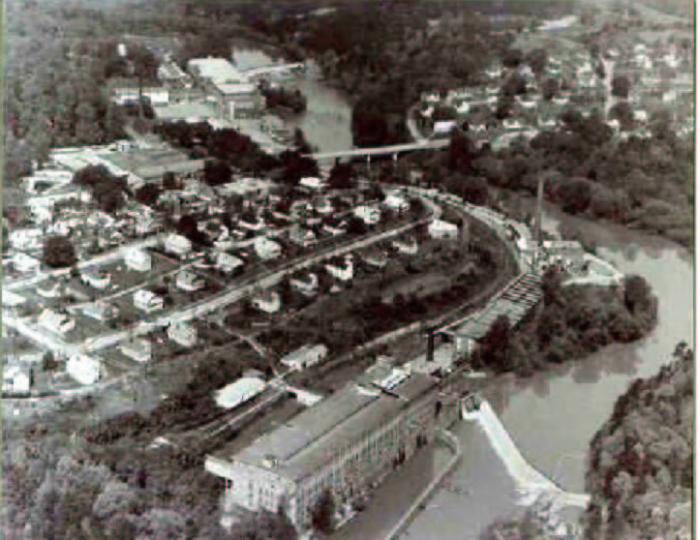
An aerial photograph taken of the
village from above Mill No. 3, probably in the late
1950's.
(Courtesy of Lindie Wells)
The clothmaking process was complex and required
careful control of the material and machinery. Click on
the following link to see some photographs of how this was
done at the Glendale Mill.
A textile mill was an incredibly complicated operation and
people often took it for granted. For a fresh look at
building and operating a mill read "It was So Complicated".
The mills at Pacolet were so successful that the Company
decided to expand into Georgia. They bought a tract of
land near Gainesville in north Georgia. This became known
as the town of New Holland and a mill was built here in
1902. It was known as Mill No. 4. Since it was built by
the Pacolet Manufacturing Company, it was also known as
Pacolet Mills No. 4 even though it was not in the town of
Pacolet Mills, SC. This name has often caused
confusion over the years.
However, a great disaster awaited the mill company, the
community and all the residents of the Pacolet River valley. On
June 6, 1903, the Pacolet Mills community and many others
were struck by the Great Pacolet River Flood. Click on the link, Pacolet River
Flood, to read the full story about this tragic event.
In just a few hours of an incredible rush of water, the
Pacolet Mills Company operation was almost destroyed. Both
Mills No. 1 and No. 2 were completely demolished.
Downriver, Mill No. 3 was badly damaged. The covered
bridge was washed away along with a church, a cotton
warehouse and its contents, a meat market, a barber shop
and the post office. A hotel that stood where the Cloth
Room does today was also destroyed. In spite of all this
devastation, only one person lost their life at Trough
Shoals. This unfortunate person was a black man named Quay
Worthy. He was a mill employee and was trying to
retrieve floating cotton bales from the water when he
drowned.
The community lost much of its population temporarily as
the people had to go to other communities to find work.
Officials of the Pacolet Mills Company asked other textile
mills in the Spartanburg area to find jobs for their
workers while they rebuilt. Most of them responded
favorably and gave many folks employment.
Efforts to rebuild began right away. Mill No. 3 was
repaired first and was back in operation in 1904. However,
what people of my generation knew as the “New Mill” was
not completed until 1907. This was named Mill No. 5 since
Mill No. 4 had been built in New Holland. The "New Mill"
was built where Mills No. 1 and No. 2 had stood before the
flood. Click on the link
to see more photographs of Mill No. 5.
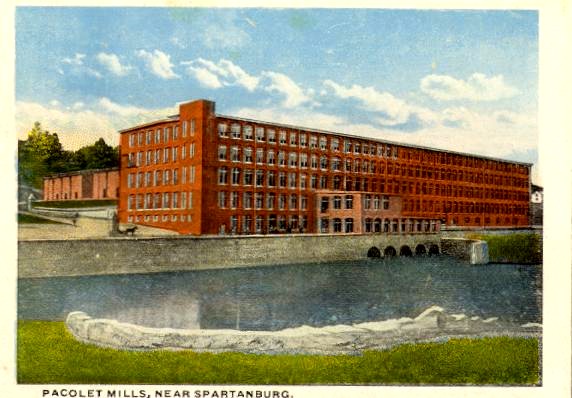
The "New Mill" or Mill No. 5
In a very strange coincidence,
tragedy also struck the Pacolet Mills Company
Mill No. 4 at New Holland , Georgia. Within the same
week, a deadly tornado stuck the community of New
Holland. The mill itself was not seriously damaged.
However, most of the towns new houses were destroyed
and approximately 100 people were killed.
